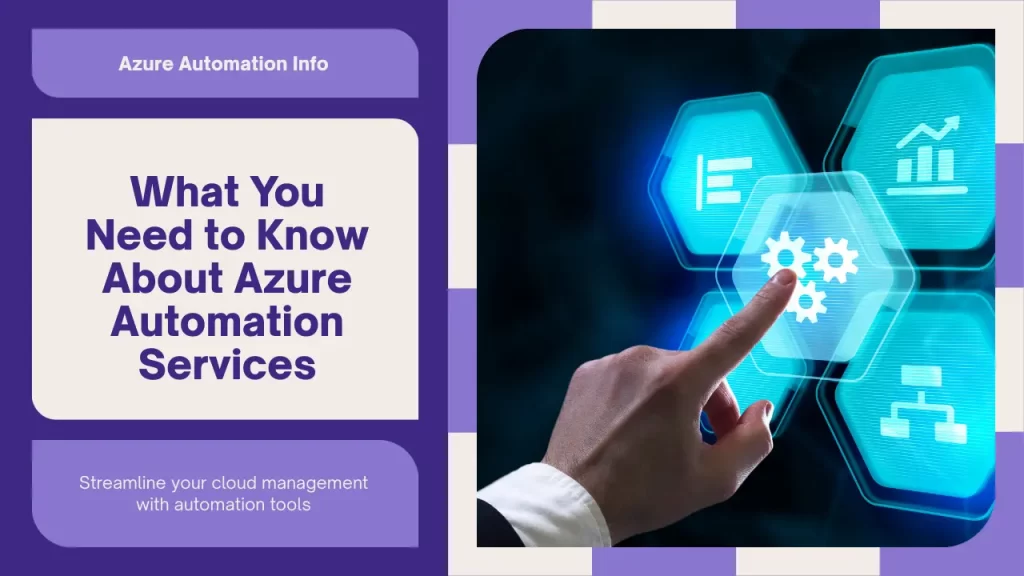Main Objective:
To provide a complete and authoritative guide on Azure Automation Services, helping users understand how to use Microsoft’s automation tools to simplify IT tasks, increase efficiency, and reduce operational costs.

What Are Azure Automation Services?
Azure Automation Services are cloud-based tools provided by Microsoft that enable you to automate tasks, orchestrate workflows, manage updates, and maintain configuration across hybrid cloud environments.
AEO Answer:
Azure Automation Services are a set of tools in Microsoft Azure that automate cloud and on-prem IT operations like scheduling, configuration, updates, and repetitive tasks.
These services help IT administrators reduce manual work, minimize errors, and improve efficiency by automating day-to-day operations.
Why Azure Automation Services Matter in 2025
With rising complexity in cloud environments and increased pressure on IT teams to do more with fewer resources, automation is no longer a luxury—it’s a necessity.
Why it matters now:
- Cloud costs are increasing.
- Downtime is expensive.
- Manual errors can cause compliance issues.
- Businesses need to scale without scaling overhead.
Azure Automation Services allow businesses to:
- Improve reliability
- Enforce compliance
- Lower operational costs

Core Components of Azure Automation Services
| Component | Description |
|---|---|
| Automation Accounts | Containers for organizing runbooks, configurations, schedules |
| Runbooks | Scripts to automate tasks using PowerShell, Python, or GUI |
| Schedules | Trigger automation tasks at specified times |
| Assets | Shared resources like variables, credentials, certificates |
| Hybrid Workers | Run automation on-premises or outside Azure |
| Update Management | Automatically patch Windows/Linux machines |
| State Configuration | Maintain configuration consistency using DSC |
Key Features Explained
Runbook Automation
Runbooks are collections of tasks automated via PowerShell, Python, or graphical workflow designers.
Update Management
Azure Automation helps manage operating system updates across virtual machines.
Configuration Management
Ensure all servers comply with organization-defined configurations using Desired State Configuration (DSC).
Integration
Integrate with:
- Azure services (VMs, Storage, SQL, etc.)
- External systems via REST APIs
- ITSM systems like ServiceNow
Job Scheduling
Run tasks on a recurring schedule or trigger them via webhooks and alerts.
Use Cases of Azure Automation
Common Use Cases:
- Auto-start/stop virtual machines
- Patch management for compliance
- Automating backups of Azure SQL
- Sending alerts based on Azure Monitor
- Orchestrating multi-step DevOps tasks
Business-Specific Use Cases:
- Automate employee onboarding/offboarding tasks
- Sync files between systems on a schedule
- Restart crashed services automatically
How Azure Automation Services Work
1. Create an Automation Account
Organize your automation assets.
2. Build or Import Runbooks
Use built-in editor, import scripts, or use templates.
3. Add Credentials and Variables
Securely store and reuse secrets and values.
4. Define Triggers
Schedule tasks, link them to alerts, or trigger via webhooks.
5. Monitor Execution
Use the Job pane to view logs, outputs, and errors.
Benefits of Using Azure Automation
| Benefit | Description |
|---|---|
| Reduced Manual Work | Automates repetitive, error-prone tasks |
| Cost Savings | Shutdown unused VMs, automate licensing checks |
| Consistency | Tasks execute the same way every time |
| Hybrid Support | Manage both cloud and on-prem systems |
| Security | Encrypted credential management and auditing |
| Scalability | Easily scale across thousands of resources |
Azure Automation vs. Other Platforms
| Feature | Azure Automation | AWS Systems Manager | Google Cloud Workflows |
|---|---|---|---|
| Scripting Language | PowerShell, Python | JSON/YAML | YAML |
| Hybrid Environment Support | Yes | Yes | Limited |
| Patch Management | Built-in | Manual setup | Not supported |
| RBAC Integration | Azure RBAC | AWS IAM | Google IAM |
| GUI Support for Workflows | Yes | No | Yes |
Azure Automation is ideal for Microsoft-centric organizations that need flexibility and hybrid control.
Step-by-Step: Setting Up Azure Automation Services
Prerequisites:
- Active Azure subscription
- Contributor or Owner role
Steps:
- Go to Azure Portal
- Create a new Automation Account
- Choose the region and resource group
- Add Runbooks
- Import or author new PowerShell/Python code
- Add assets like credentials and variables
- Set schedules or webhooks
- Monitor job output and logs
Done! You’ve successfully deployed Azure Automation.
Azure Automation Runbooks: Deep Dive
Types:
- PowerShell Runbooks
- Python Runbooks
- Graphical Runbooks
- Hybrid Runbooks
Sample PowerShell Runbook (Auto Shutdown VMs):
$vmList = Get-AzVM
foreach ($vm in $vmList) {
Stop-AzVM -Name $vm.Name -ResourceGroup $vm.ResourceGroupName -Force
}
Best Practices:
- Use source control (GitHub)
- Modularize your runbooks
- Use error handling and logging
Security and Compliance in Azure Automation
Security Features:
- RBAC and Azure AD integration
- Managed Identities to access Azure services securely
- Encrypted assets for credentials and certificates
- Job logs and auditing for traceability
Compliance Standards:
- ISO 27001
- GDPR
- HIPAA
- SOC 2
Use Azure Policy to enforce governance across all automation services.

Challenges and Best Practices
Challenges:
- Learning curve for beginners
- Debugging scripts
- Managing hybrid infrastructure
Best Practices:
- Keep runbooks small and reusable
- Test in non-prod before going live
- Set up alerts and monitoring
- Regularly review credentials and RBAC roles
Real-World Case Studies
Finance Company
Automated patching for 1,200 VMs—reduced downtime by 60% and improved compliance.
Healthcare Provider
Used runbooks for alert-based escalation and remediation—improved response time by 75%.
University IT Team
Deployed Hybrid Workers to control both on-campus and cloud systems—saved 200+ hours/month.
Future of Azure Automation Services
Azure Automation is evolving with AI and Copilot integrations:
- Predictive auto-scaling
- Natural language script generation
- AI anomaly detection
- Event-driven remediation
In 2025 and beyond, AI-enhanced automation will further reduce the manual effort needed for complex IT tasks.
Frequently Asked Questions (AEO Optimized)
What is Azure Automation Services used for?
It is used to automate IT tasks such as VM management, patching, scheduling, configuration, and monitoring across hybrid cloud environments.
Are Azure Automation Services free?
Azure offers 500 free minutes per month. Charges apply beyond that based on job runtime and resource usage.
Can I use Azure Automation for on-premise servers?
Yes, via Hybrid Runbook Workers that allow scripts to run on on-prem or hybrid environments.
What scripting languages are supported?
PowerShell, Python, and a graphical editor are supported.
Is Azure Automation secure?
Yes. It uses encryption, role-based access control, managed identities, and auditing features.
Final Thoughts
Azure Automation Services give you the power to simplify your cloud and hybrid operations, reduce costs, increase uptime, and enforce consistency across environments. With built-in tools for update management, configuration control, and robust security, it’s one of the most valuable services in the Microsoft Azure ecosystem.
If you’re looking to modernize your IT processes in 2025, investing time in Azure Automation will pay off significantly



